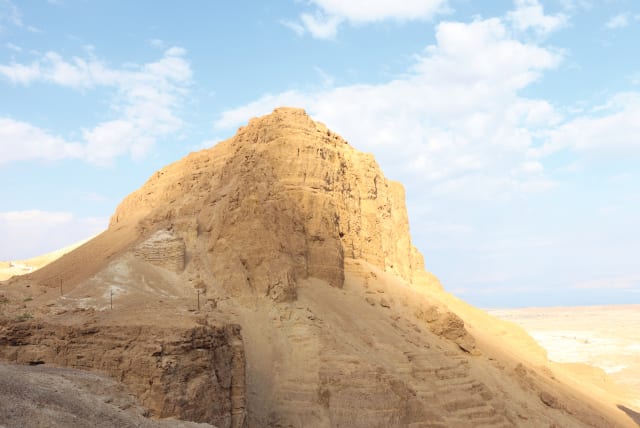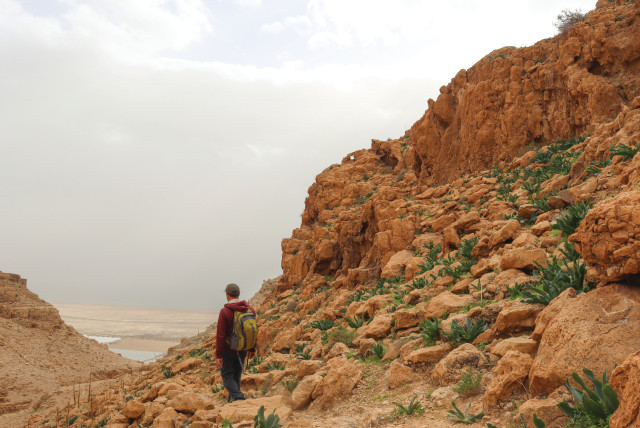Hiking along Nahal Qumran, Masada: Jewish nationalist symbols of Zionism

May we merit complete victory in this war and see a time when no more tears must be shed over fallen soldiers.
Nahal Qumran, winter 2022: my first flash flood in Israel.
We hike toward the desert canyon, then continue up to a picturesque spot overlooking a deep gorge. We stop and eat breakfast there, while gazing out at a majestic view. Over hot coffee, we take in the impressive valley, rocky precipices, and hidden caves; the air is cool and clear. Afterward, we return to the mouth of the canyon; the sky has now become cloudy and grey.
By the time we finish visiting the site of ancient Qumran, a light mist has begun to fall. I notice onlookers gathering at the edge of the canyon, presumably to wait for the impending flash flood. We join them in a safe spot above the channel. Suddenly, out of nowhere, a river appears, a flash flood flowing through with great force despite the minute amount of precipitation, washing dried brambles and refuse through Nahal Qumran at top speed.
Watching this impressive rush of water, I think of Psalm 126, in which we implore God to: “Bring back our captivity like Afikim BaNegev,” flash floods in the desert. I’ve uttered this psalm before the Birkat Hamazon (Grace After Meals) every Shabbat since I was a child. But until now, I had never been able to fully visualize this metaphor.
Now at Nahal Qumran, I am witnessing a desert stream appear out of nowhere, caused by rainfall miles away in the Judean Hills. Like this flash flood in the desert, the Jews hope to suddenly return to Israel from the lands of exile during the times of redemption. As I contemplate the influx of Jews that flowed into Israel from all over the world after the founding of the state in 1948, I can’t think of a more apt metaphor.
The symbol of Jewish nationalism
Qumran, where we witnessed this flash flood, is most well-known for the Second Temple period scrolls found in its caves, the earliest Biblical parchments in existence. Although there is still much debate over who actually lived in the village of Qumran, many scholars suggest that a group of devout Jews called Essenes inhabited the area. Some say that the village and nearby caves were also used by Bar Kochba rebels, seeking to escape Roman oppression. Most scholars agree that when Qumran was destroyed by the Romans in 68 CE, some of the inhabitants of the area fled to nearby Masada.
MASADA IS another secluded desert hideaway near the Dead Sea, thought to have been inhabited by a sect of Sicari Jews seeking refuge from Roman domination. In the early days of Jewish nationalism, Masada became a Zionist symbol for Jews in Israel, a symbol of a people willing to struggle for their beliefs and their principles at all costs.
It was used to represent those who were willing to die rather than live under the subjugation of a foreign power. Climbing its steep and rocky ascent became a rite of passage for young Jews in the land of Israel in the early 20th century, as they sought to understand what it meant to defy physical limitations in order to accomplish something great.
A few years ago, my son, now a soldier fighting in Gaza, hiked from the desert city of Arad to the fortress of Masada with his two best friends. They made their way along the trail, past Bedouin settlements and above canyons, enjoying stark desert beauty by day and camping out at night. At the end of their multi-day journey, they reached the western side of Masada fortress, where Roman legions had once built a ramp to penetrate the fortress. Together, the three friends camped out under the magnificent sky at the foot of Masada, a symbol of Jewish nationalism.
One of these three friends was Ephraim Jackman, who was tragically killed in battle in Gaza this December. Ephraim was an exceptional person, an unusually accomplished musician and Torah scholar for his young age, a role model for everyone around him. Despite the dangers involved, he was proud to be a soldier in the war in Gaza, defending our people and our land against an existential threat. He died fighting heroically for a cause that Jews have been defending in Israel since the times of Qumran and Masada: the right to live as a free people in our own land.
This freedom doesn’t come without struggle. Psalm 126 goes on to describe the time of redemption in further detail, “Those who sow in tears will reap with songs of joy.” Throughout Israel’s 75 years of nationhood, we’ve shed many tears over soldiers, fathers, and sons who have died defending our country.
But we have also been lucky enough to witness the first fruits of redemption, a land coming to life as our nation has been restored to its borders. Israel has become a country that offers freedom and safety to Jews returning from places of exile, a place where we compose and sing our own songs of celebration.
May we merit complete victory in this war and see a time when no more tears must be shed over fallen soldiers. May the heroic efforts of Ephraim Jackman and others who have fallen in battle achieve their ultimate objective: to restore unity and safety to the land of Israel, and to grant us the privilege to live as Jews in our own land.
The writer is the creator of Hiking the Holyland (www.hikingintheholyland.com). Her latest book is From Southerner to Settler: Unexpected Lessons from the Land of Israel (www.fromsouthernertosettler.com)
Jerusalem Post Store
`; document.getElementById("linkPremium").innerHTML = cont; var divWithLink = document.getElementById("premium-link"); if (divWithLink !== null && divWithLink !== 'undefined') { divWithLink.style.border = "solid 1px #cb0f3e"; divWithLink.style.textAlign = "center"; divWithLink.style.marginBottom = "15px"; divWithLink.style.marginTop = "15px"; divWithLink.style.width = "100%"; divWithLink.style.backgroundColor = "#122952"; divWithLink.style.color = "#ffffff"; divWithLink.style.lineHeight = "1.5"; } } (function (v, i) { });

